 |
|||
|
|
|||
|
|
ArchivesMay 20032003 Archives Environmental Health Education in Colonias along the Texas-Mexico Border and Other Rural Disadvantaged Communities of TexasBy Irma N. Ramos, MD
Irma Ramos is the Director of the COEP of the Center in Environmental and Rural Health at Texas A&M in College Station, Texas. After five successful years in this role, she will be leaving Texas A&M in August 2003 to join the faculty at the School of Public Health and Information Sciences, University of Louisville Health Sciences Center, in Louisville, Kentucky. COEP OverviewAs I reflect back on the NIEHS Community Outreach and Education Program (COEP) at the Center for Environmental and Rural Health (CERH) and its impact on the well-being of Texans, I take great pride and satisfaction in the many successes we have enjoyed. The aim of our COEP is to educate Texans on how to reduce potential environmental exposures associated with human illness, providing them with scientifically sound information to deal with environmental issues. In working towards these goals, our COEP has:
Outstanding partnerships with federal and state agencies and other COEPs have allowed us to reach many disadvantaged populations in Texas and beyond. We have provided outreach and education not only to lay community health educators and Texas-Mexico border region residents, but also to health care professionals along the Texas-Mexico border, rural middle school students and their teachers throughout Texas, and our fellow residents in the Brazos Valley. Below I summarize some of the COEP’s achievements. Environmental Health Training of Promotores in ColoniasEnvironmental Health Issues in Colonias
In recent years the Texas-Mexico border region has experienced an explosion of growth in population and industrial activity. Although growth has resulted in economic opportunities, it has also intensified the environmental health and social challenges. Among the border states, Texas has the largest number of colonias – approximately 1,800 communities, with more than 500,000 residents. Sixty-five percent of all residents, and 85% of residents under the age of 18, were born in the United States. These Americans live in extreme poverty and often are unaware of the services that the United States and Texas can provide for them. Education is a key to addressing the problems faced by colonia residents, but reaching out to these communities poses unique challenges that require unique approaches. Ninety-eight percent of the residents are Hispanic and speak little or no English. The language barrier represents a major obstacle to effective public health education and outreach efforts in this region of Texas. One of the greatest advantages afforded to me by my Hispanic heritage is the opportunity to communicate with them in their own language. This has helped overcome many of the barriers often faced by “outsiders.” Environmental Health Training for Promotoras In 1998 our COEP teamed with the Center for Housing and Urban Development Colonia Program and the South Texas Promotoras Association to develop and implement a community outreach and education program of sustainable environmental health in the colonias. Texas A&M is located about 380 miles from the Mexico border. This distance, significant even by Texan standards, made frequent visits to colonias logistically difficult. Still, COEP members have made approximately 50 trips to the colonias over the past five years. We have found that face-to-face communication has been critical in establishing trusting relationships.
Our COEP is the first to bring environmental health education to promotores and colonia residents in the Lower Rio Grande Valley of Texas. Extramural resources have been secured over the years not only to train promotores but also to send them to their respective communities to educate their neighbors. This approach has enabled us to educate much larger numbers of colonia residents. The COEP developed a bilingual environmental health science training curriculum in collaboration with instructors, scientists, and physicians from CERH, University of Texas M.D. Anderson Cancer Center, and University of Texas Medical Branch. The curriculum uses a “train-the-trainer” model of education and outreach. It teaches promotores about environmental health and prepares them to teach their neighbors what they have learned. Content is based on a pre-intervention assessment of colonia residents’ health concerns developed by Center investigators, as well as data from the Texas Department of Health and the Centers for Disease Control regarding environmental health conditions along the US-Mexico border. Instruction is geared at the middle school level to facilitate dissemination of scientific and medical principles to individuals with varying educational backgrounds.
Strength of the Promotores Program The ongoing work in the colonias has also served to promote strong partnerships between and among colonia residents, community-based organizations, clinicians, public health professionals, and researchers. These partnerships will leave a legacy of disease prevention, behavior modifications, and environmental health promotion in this region of Texas. The train-the-trainer model will help translate old and new scientific findings into knowledge that can be adopted by all community residents. When neighbors teach neighbors, the message is received with greater trust and is more readily acted upon.
Spreading the Message About Promotores
Safe Drinking Water Training for Rural Health Care Professionals and PromotoresRecognizing that environmental health training could benefit health care professionals (1988 Institute of Medicine Report Notes), as well as promotores, our COEP developed a new curriculum—“A Closer Look at Drinking Water”—focusing on safe drinking water and waterborne illnesses. The curriculum was certified by the Texas Department of Health for continuing medical and nursing education in December of 2002. During a special training session held in McCallen, Texas, we trained 50 health care professionals, primarily physicians and nurses. The program was funded by investigator-initiated contract support from the US Health Resource Services Administration and the US Environmental Protection Agency. Special thanks go to our speakers Drs. K. C. Donnelly, PhD (Center Scientist); Charles Farnsworth, PhD (Instructional Designer); Brian Smith, MD (Director, Texas Department of Health-Region 6); and Ken Ramos, PhD (Center Director); for their outstanding efforts in professional training. We also developed a Spanish version of the waterborne illness curriculum to train promotores and colonias residents. In February 2003 we successfully trained 23 promotores in Hidalgo County, TX, and they continue to provide education in Progresso, Las Milpas and San Carlos colonias.
Reaching Out to Local Audiences through Television
The morning show is extremely popular, with over 40, 000 viewers per day. This is significant considering that the entire Bryan-College Station population consists of approximately 100, 000 people. The feedback received on our segment has always been positive, as evidenced by the longevity of the program, free of charge to the Center. K-12 Education through PEERAnother important component of the COEP is our K-12 education program, directed by Dr. Larry Johnson. Our primary K-12 efforts are channeled through the PEER (Partnership of Environmental Education and Rural Health) program, which aims to enhance teachers’ ability to motivate students, using an instructional approach that demonstrates how mathematics, English language arts, social studies, and science relate to real world environmental health science problems and issues. PEER is supported by an NIEHS EHSIC (Environmental Health Science as an Integrative Context) grant. (Read more about the PEER program * or the EHSIC grant program *.) The PEER Model To enhance the accessibility of PEER resources to rural schools, PEER posts scientist presentations and interviews, as well as the curricular modules, on-line. (View the presentations and interviews * or the modules *.)
Hard River Escape: A PEER Adventure in the Ukraine In this process, students read and answer questions about the adventure and summarize major points of the story. English language arts skills, including vocabulary, grammar, language usage, and writing appear in all adventures. In addition, students apply mathematics to solve problems related to elements of the adventure. They explore perspective in writing and are asked to write informative (newspaper account of the Chernobyl nuclear accident) and persuasive (travel brochure for Kiev) essays. They determine absolute and relative global location of the Ukraine and take a tour along the Dneiper River where they learn about local geography, the industrial economy, agricultural practices, and how these have added to growing environmental concerns about pollution on the river. Other environmental concerns include air and water pollution, deforestation, and radiation contamination. Evidence of water pollution includes dead fish in the river, foul smelling water, pipes dumping factory wastes, trash floating in the Dneiper River, and deformed (five legged) frogs. The adventure story gives clues as to possible causes of the deformed frogs, including nuclear radiation, industrial wastes, pesticides, oil drilling and refining, agricultural runoff, and mining/manufacturing operations, prompting students to consider how deformed frogs may serve as an indicator of danger to humans. Students use mathematics to calculate radiation dose fractions, distance traveled, river water flow rates, international currency exchange, environmentally-induced tumor growth, and toxicity levels. In conclusion they write a description of their own city, noting environmental challenges and proposing efforts to clean up local pollution. Measuring the Impact of PEER Initial field tests of the PEER on-line modules have provided our research team with valuable information for enhancing and expanding the PEER model. For example, based on pre-test/post-test scores for the various sections of the “Water’s the Matter” module, middle school students’ knowledge increased measurably as follows:
In addition, based on a preliminary study of scientists’ visits, PEER curricular materials have been well received by students. Specifically, out of 1,765 students who evaluated the scientists’ presentations,
Closing ThoughtsMy involvement with the COEP over the past five years has been a rewarding experience! It has opened new doors and given me a sense of accomplishment and purpose knowing that we have made a difference for the people of Texas. For more information about the TAMU COEP, visit the COEP’s Web site: http://cerh.tamu.edu. * For specific information on the colonias program, contact: Irma N. Ramos, MD For specific information on the PEER Program, visit the PEER web site: http://peer.tamu.edu or contact: Larry Johnson, PhD Back to Spotlight archives *Note: An asterisk (*) indicates a link to a site outside the COEP Resource Center. If you follow such a link, use your browser's "Back" button to return to the COEP Resource Center. For more information, read our disclaimer about links to other sites. |
||||||||||||||||||
 |
Resource Center Home | Contact Us |

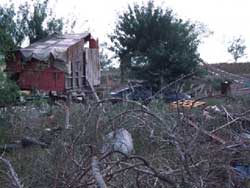
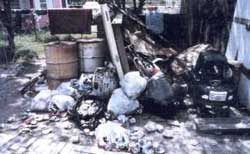
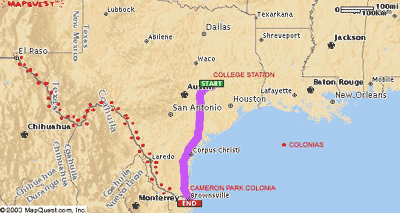
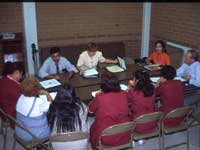
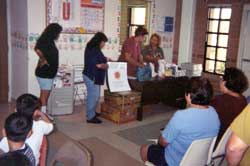
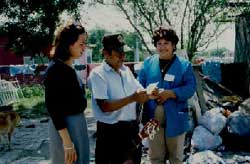
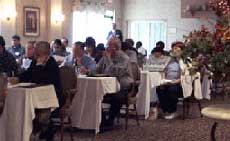
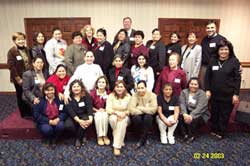
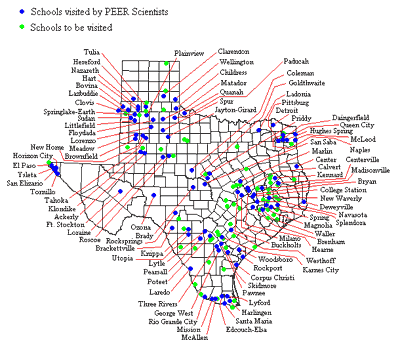
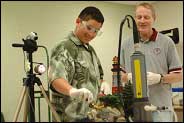 Dr.
John Hunter, PEER co-investigator, teaching a middle school student.
Dr.
John Hunter, PEER co-investigator, teaching a middle school student.